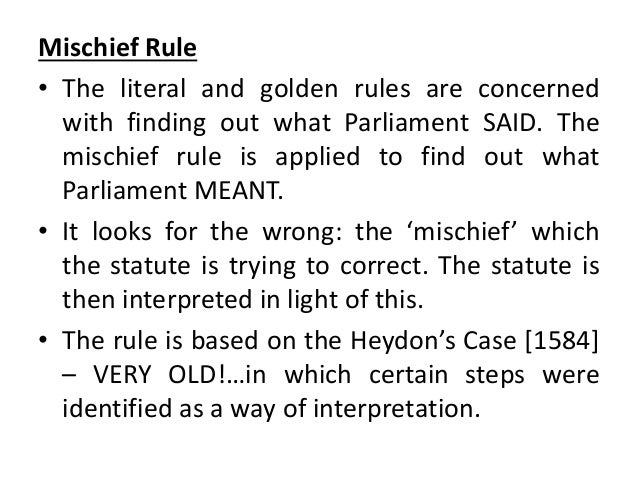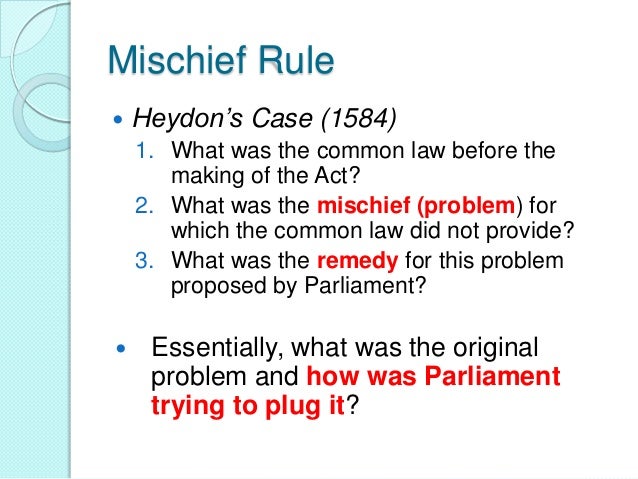The rule was first set out in Heydons Case 1584 76 ER 637 3 CO REP 7a where the court held that four points should be taken into consideration. Rule of Exceptional Construction.

Mischief Rule
1

Unit 1 Law Making Topic 3 Statutory Interpretation
LITERAL RULE PLAIN MEANING RULE STRICT APPROACH TO STATUTORY INTERPRETATION.

Heydon's rule of interpretation. Heydons Case 1584 76 ER 637 is considered a landmark case as it was the first case to use what would come to be called the mischief rule for statutory interpretationThe mischief rule is more flexible than the golden or literal rule in that the mischief rule requires judges to look over four tasks to ensure that gaps within the law are covered. The mischief rule was established in Heydons Case. Explain - Literal Rule Mischief Rule aka Rule in Haydons case Golden Rule Rule of Harmonious Construction Nosciur a sociis Ejusdem generis Reddendo singul singuis.
It is known as Heydons rule because it was given by Lord Poke in Heydons case in 1584. It is known as Heydons rule because it was given by Lord Poke in Heydons case in 1584. It provides that where the words of the provisions of a statute are clear the courts ought to apply the words as they are even where the interpretation of the statutes leads to something which is unreasonable or absurd it Is not the duty of the court to make sense of the provisions of the statutes that is the.
Coke in Re Heydons Case 1584. Rule of Literal Interpretation. This was used in the times of political reality where judges are the main makers of law.
Introduction Statutory interpretation is the process of interpreting and applying legislation to decide. The mischief rule is known as the most flexible rule and it is established in the Heydons case. Purposive interpretation was introduced as a form of replacement for the mischief rule the plain meaning rule and the golden rule to determine cases.
Index page for sources of law with some information on the Separation of powers Parliamentary Sovereignty and the Rule of Law. This rule now attained the status of classic is known as the Mischief Rule. So possessed and the said Ware and Ware so seised as aforesaid the said warden and canons by their deed indented dated 12 January anno 30 H.
Every law has a certain purpose set so judges should take those purposes into consideration and it should be read as a whole while interpreting. It is also sometimes referred to as the rule in. This rule of interpretation is adopted when there is a conflict between two or more statutes or between two provisions of the same statute.
In the Heydons case it was held that there are four things which have to be followed for true and sure interpretation of all the statutes in general which are as follows-. _____ is also known as Heydons Rule and Mischief Rule. For the sure and true interpretation of all statutes in general be they penal or beneficial restrictive or enlarging of the common law four things are to be discerned and considered.
The third basic rule of interpretation of statutes is the mischief rule of Interpretation. In Heydons case the following four points are taken into consideration while interpreting a statute-What was the common law before the making of the Act. If the _____ used in a statute makes it clear that a _____ sense is intended the rule of Ejusdem Generis shall not apply.
Under the mischief rule the courts role is to suppress the mischief the Act is aimed at and advance the remedy. In the Heydons case it was held that there are four things which have to be followed for true and sure interpretation of all the statutes in general which are as follows-. Only when the words in the legislation seem unclear and ambiguous may the courts turn to secondary and tertiary aids.
This rule was laid down by the Lord. MISCHIEF RULE OF INTERPRETATION. Heydons Case This case helps us.
The mischief rule was established in Heydons Case 1584 EWHC Exch J36 Case summaryIn Re Sussex Peerage it was held that the mischief rule should only be applied where there is ambiguity in the statute. 5 marks each Answer 1a The concept of justice equity and good conscience was introduced by Impeys Regulations of 1781. The historical source of purposive interpretation is the mischief rule established in Heydons Case.
A rule of statutory interpretation that attempts to determine the legislators intention to determine the mischief and defect to give ruling to implement the effective remedy. The Mischief Rule is considered the widest discretion to judges which focuses on the intention of the Parliament rather than the words given. The mischief rule was laid down in the landmark Heydons Case in 1584 where the court said four issues need to be considered when interpreting statutes.
The mischief rule is contained in Heydons Case 1584 3 Co Rep 7 where it was stated that for the true interpretation of all statutes four things are to be considered. Did lease the same to Heydon the defendant for eighty years rendering certain rents severally for several parcels. Examine the common law prior to the Act locate the mischief or defeat in the common law identify the remedy Parliament meant to propose to eliminate the mischief and finally to give effect to that remedy.
And further that the said S. D Explain the Purposive Rule of Interpretation under the General Clauses Act 1897. It is called as mischief rule because the focus is on curing the mischief.
The main rules of the functional approach are the Mischief Rule as formulated in the Heydons Case 41 and the Golden Rule. And found that the said several rents in Heydons lease reserved were the ancient and accustomed. In Re Sussex Peerage it was held that the mischief rule should only be applied where there is ambiguity in the statute.
The mischief rule of statutory interpretation is the oldest of the rules. State the circumstances when these rules are applied by the courts. It is called as mischief rule because the focus is on curing the mischief.
This rule is also known as the rule in the Heycons case 1594 because this rule was laid down by Lord Coke for the first time in Re Heydons Case. In personal law disputes the courts are required to apply the. 42 The rules of statutory interpretation In this part we will explore the number of rules developed by the courts to assist with the.
The mischief rule of statutory interpretation is the oldest of the rules. This is known as the golden rule of textual interpretation. Hence it is known as the rule in Heydons case.
Mischief rule in statutory interpretation the rule that asks what the law was before an Act and what defects there were that were addressed by the legislation under construction. A THE RULES OF STATUTORY INTERPRETATION 1. Further this rule has also been named as purposive construction.
The mischief rule would only be use if there is still ambiguity even though it had been followed in the literal rule and golden rule. The rule is contained in Heydons Case 1584 where it was said that for the true interpretation of a statute four things have to be considered. Mischief rule is the second primary rule of interpretation of statutes.
In this method of interpretation it is believed that the plain grammatical meaning of the words as they are found in the legislation constitutes the intention of the legislature and thus the purpose of the legislation. One time tested and well accepted mode of interpreting a statute especially a new statute is to apply the mischief rule first spoken of in Heydons case 76 ER 637 which contains a four-point formula acting as an aid in construing a new law or provision.

Statutory Interpretation The Mischief Rule Learning Objectives All Learners Will Be Able To Demonstrate Understanding Of The Literal Golden And Mischief Ppt Download

Statutory Interpretation
English Legal System Statutes And Interpretation Of Statutes

Mischief Rule Of Interpretation Sps Ppt Mischief Rule Of Interpretation Prof Dr S P Srivastava Department Of Law And Governance Basics U2022 This Course Hero

Mischief Rule Article1000 Com
The Mischief Rule Pdf Statutory Interpretation Virtue
1
Nanopdf Com

